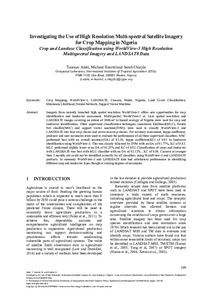| dc.contributor.author | Alabi, Tunrayo |
| dc.contributor.author | Haertel, M. |
| dc.contributor.author | Chiejile, S. |
| dc.contributor.author | Alabi, Tunrayo |
| dc.date.accessioned | 2019-12-04T10:58:20Z |
| dc.date.available | 2019-12-04T10:58:20Z |
| dc.date.issued | 2016 |
| dc.identifier.citation | Alabi, T., Haertel, M. & Chiejile, S. (2016). Investigating the use of high resolution multi-spectral satellite imagery for crop mapping in Nigeria crop and landuse classification using WorldView-3 high resolution multispectral imagery and LANDSAT8 data. proceedings of the 2nd International Conference on Geographical Information Systems Theory, Applications and Management (GISTAM 2016). (pp. 109-120), Setubal, Portugal |
| dc.identifier.isbn | 978-989-758-188-5 |
| dc.identifier.uri | https://hdl.handle.net/20.500.12478/967 |
| dc.description.abstract | Imagery from recently launched high spatial resolution WorldView-3 offers new opportunities for crop
identification and landcover assessment. Multispectral WorldView-3 at 1.6m spatial resolution and
LANDSAT8 images covering an extent of 100Km² in humid ecology of Nigeria were used for crop and
landcover identification. Three supervised classification techniques (maximum likelihood(MLC), Neural
Net clasifier(NNC) and support vector machine(SVM)) were used to classify WorldView-3 and
LANDSAT8 into four crop classes and seven non-crop classes. For accuracy assessment, kappa coefficient,
producer and user accuracies were used to evaluate the performance of all three supervised classifiers. NNC
performed best with an overall accuracy(OA) of 92.20, kappa coefficient(KC) of 0.83 in landcover
identification using WorldView-3. This was closely followed by SVM with an OA of 91.77%, KC of 0.83.
MLC performed slightly lower at an OA of 91.25% and KC of 0.82. Classification of crops and landcover
with LANDSAT8 was best with MLC classifier with an OA of 92.12% , KC of 0.89. Cassava at younger
than 3 months old could not be identified correctly by all classifiers using WorldView-3 and LANDSAT8
products. In summary WorldView-3 and LANDSAT8 data had satisfactory performance in identifying
different crop and landcover types though at varying degrees of accuracies. |
| dc.format.extent | 109-120 |
| dc.language.iso | en |
| dc.subject | Cassava |
| dc.subject | Maize |
| dc.subject | Neural Network |
| dc.title | Investigating the use of high resolution multi-spectral satellite imagery for crop mapping in Nigeria crop and landuse classification using WorldView-3 high resolution multispectral imagery and LANDSAT8 data |
| dc.type | Conference Proceedings |
| cg.contributor.crp | Climate Change, Agriculture and Food Security |
| cg.contributor.affiliation | International Institute of Tropical Agriculture |
| cg.coverage.region | West Africa |
| cg.coverage.country | Nigeria |
| cg.authorship.types | CGIAR single centre |
| cg.iitasubject | Cassava |
| cg.iitasubject | Crop Systems |
| cg.iitasubject | Farming Systems |
| cg.iitasubject | Food Security |
| cg.iitasubject | Land Use |
| cg.iitasubject | Maize |
| cg.publicationplace | Setubal, Portugal |
| cg.accessibilitystatus | Limited Access |
| local.dspaceid | 77687 |
| cg.targetaudience | Scientists |

